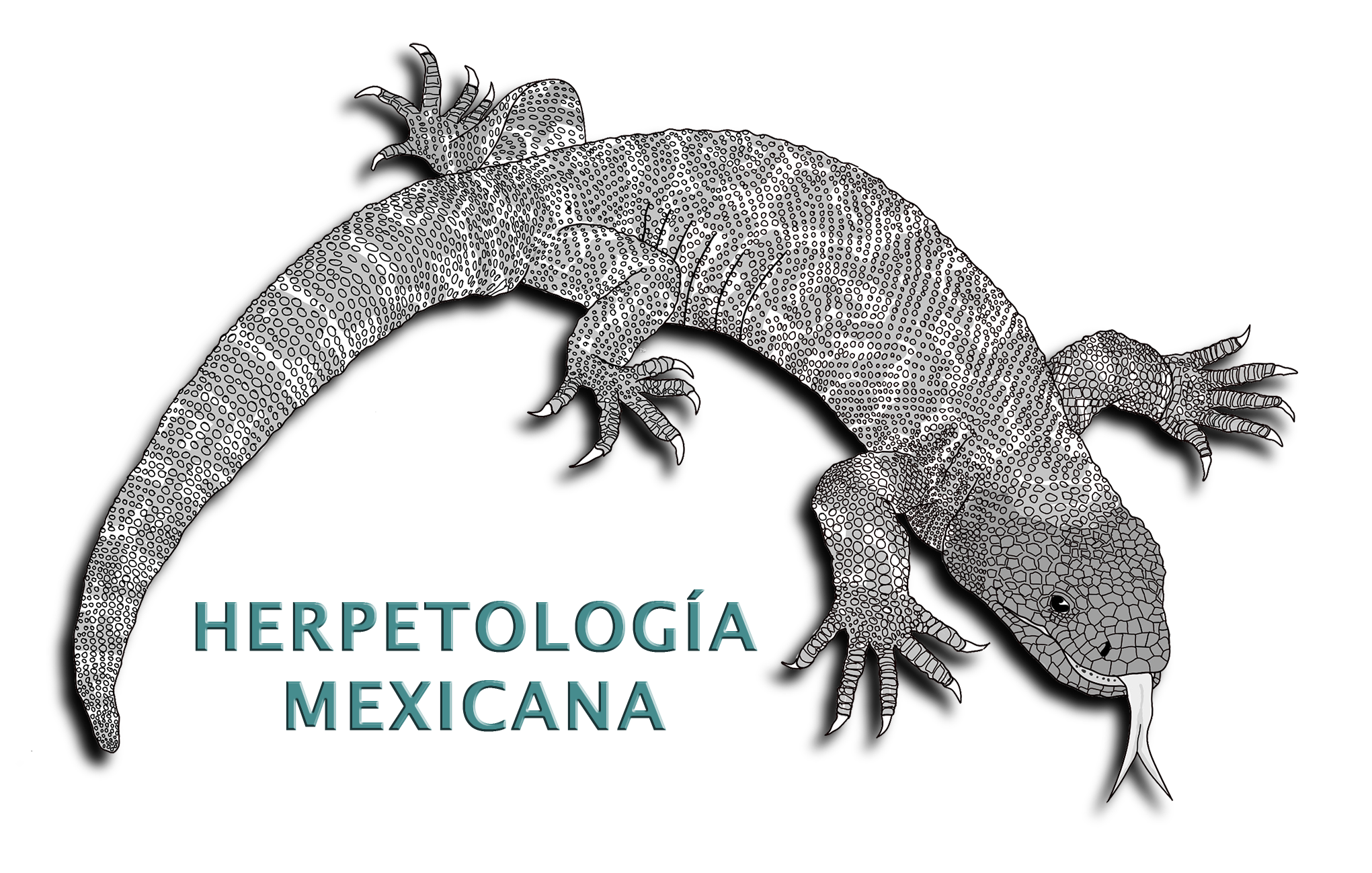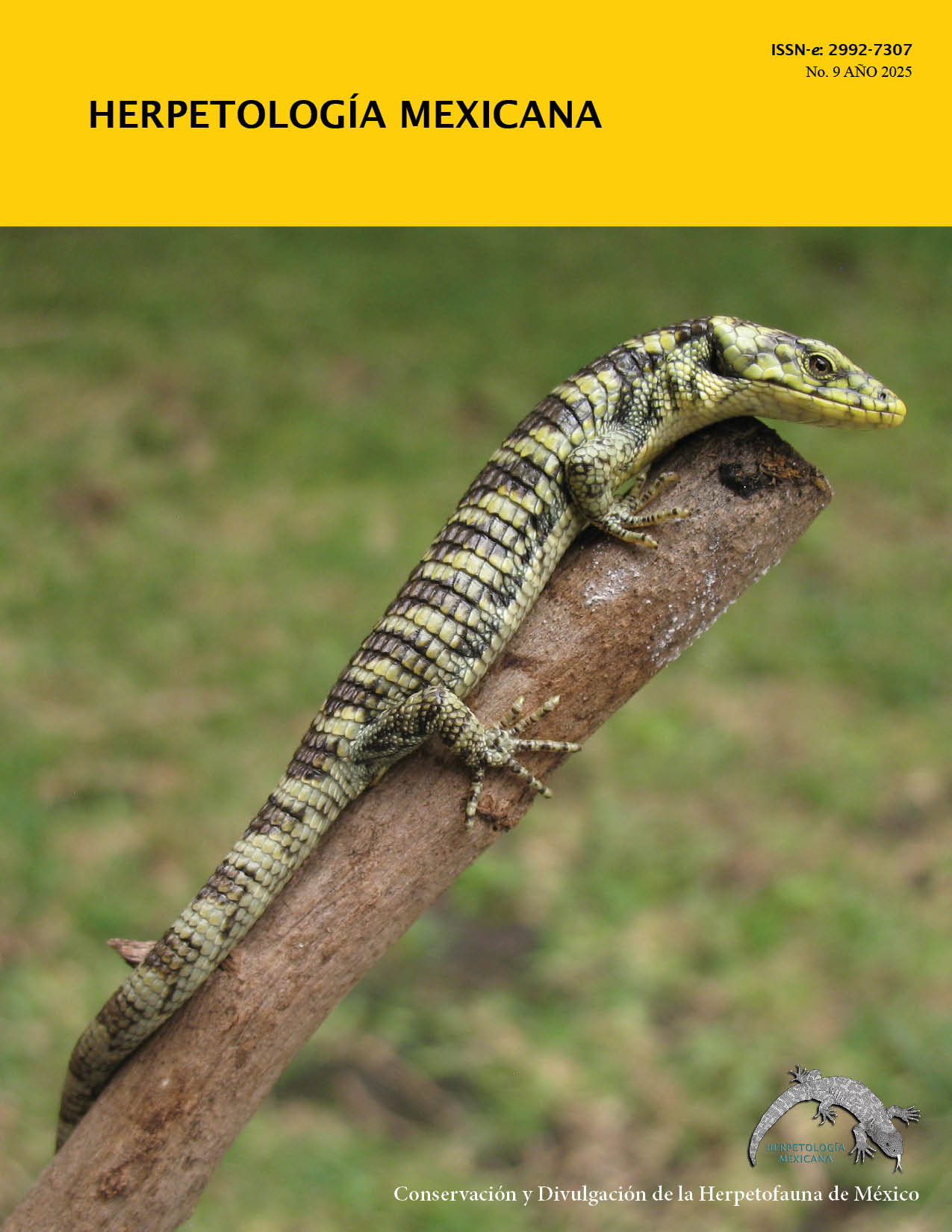Peligro en la ciudad: dos casos de anomalías corporales en el Huico Correlón, Aspidoscelis costatus costatus
DOI:
https://doi.org/10.69905/jpf2n511Palabras clave:
deformidad, hueso fracturado, lagartija, pérdida de dígitos, urbanizaciónResumen
La urbanización es una de las causas más importantes de pérdida o alteración del hábitat y presenta varios desafíos para los animales y su sobrevivencia. En las poblaciones de reptiles es posible observar la presencia de heridas y anomalías morfológicas en los organismos que impactan negativamente su sobrevivencia. Estas anomalías pueden ser producto de eventos de depredación fallidos, agresiones entre individuos o actividades humanas. En este trabajo describimos la observación de anomalías en dos individuos de Aspidoscelis costatus costatus (Huico Correlón) en un área urbana. El primer individuo presentó pérdida de dígitos en una de sus extremidades. El segundo individuo tenía una fractura en la cola. La comprensión de las implicaciones de las heridas en lagartijas puede derivar en un mejor manejo de las poblaciones de lagartijas urbanas.
Referencias
Aguilar-Moreno, M., F. J. Rodríguez-Romero, A. Aragón-Martínez, J. A. Muñoz-Manzano, G. Granados-González & O. Hernández-Gallegos. 2010. Dimorfismo sexual de Aspidoscelis costata costata (Squamata: Teiidae) en el sur del Estado de México, México. Revista Chilena de Historia Natural, 83: 585-592.
Amadi, N., R. Belema, H. Obodo Chukwu, D. Dendi, A. Chidinma, R. Meek & L. Luiselli. 2020. Life in the suburbs: artificial heat source selection for nocturnal thermoregulation in a diurnally active tropical lizard. Web Ecology, 20 (2): 161-172. DOI: https://doi.org/10.5194/we-20-161-2020
Ashton, K. G. 2003. Sexing Cnemidophorus lizards using a postanal scale character. Herpetological Review, 34: 109-111.
Avery, R. A., C. F. Mueller, J. A. Smith & D. J. Bond. 1987. The movement patterns of lacertid lizards: speed, gait and pauses in Lacerta vivipara. Journal of Zoology, 211 (1): 47-63. DOI: https://doi.org/10.1111/j.1469-7998.1987.tb07452.x
Balakrishna, S., M. S. Amdekar & M. Thaker. 2021.
Morphological divergence, tail loss, and predation risk in urban lizards. Urban Ecosystems, 24: 1391-1398. DOI: https://doi.org/10.1007/s11252-021-01122-6
Balderas-Valdivia, C. J. 2002. Lo interesante está al final, en la cola reptiliana. ¿Cómo ves?, 41:10-14.
Barley, A. J., A. Nieto-Montes de Oca, T. W. Reeder, N. L. Manríquez-Morán, J. C. Arenas-Monroy, O. Hernández-Gallegos & R. C. Thomson. 2019. Complex patterns of hybridization and introgression across evolutionary timescales in Mexican whiptail lizards (Aspidoscelis). Molecular Phylogenetics and Evolution, 132: 284-295. DOI: https://doi.org/10.1016/j.ympev.2018.12.016
Bateman, P. W. & Fleming, P. A. 2009. To cut a long tail short: a review of lizard caudal autotomy studies carried out over the last 20 years. Journal of Zoology, 277: 1-14. DOI: https://doi.org/10.1111/j.1469-7998.2008.00484.x
Bohus, A., B. Gál, B. Barta, I. Szivák, K. Karádi-Kovács, P. Boda, J. Padisák & D. Schmera. 2023. Effects of urbanization induced local alterations on the diversity and assemblage structure of macroinvertebrates in low order streams. Hydrobiologia, 850: 881-899. DOI: https://doi.org/10.1007/s10750-022-05130-1
De la Rosa-Silva, E., A. Gómez-Benítez, D. Sánchez-Manjarrez, E. Oviedo-Hernández, G. Andrade-Soto, J. M. Walker & O. Hernández-Gallegos. 2023. A brief review of limb anomalies in lizards and presence of ectrodactily in Aspidoscelis costatus (Squamata: Teiidae). Revista Latinoamericana de Herpetología, 6 (4): 127-131. DOI: https://doi.org/10.22201/fc.25942158e.2023.4.817
Díaz-Marín, C. A., T. Carmona-Zamora & A. Ramírez-Bautista. 2023a. Missing toes in the graphic spiny lizard Sceloporus grammicus from central Mexico. The Herpetological Bulletin, 164: 37-38. DOI: https://doi.org/10.33256/hb164.3738
Díaz-Marín, C. A., T. Carmona-Zamora, C. Mendoza-Almeralla & A. Ramírez-Bautista. 2023b. First record of ectomely in Phrynosoma orbiculare (Squamata: Phrynosomatidae). Revista Latinoamericana de Herpetología, 6 (3): 172-175. DOI: https://doi.org/10.22201/fc.25942158e.2023.3.751
DOF (Diario Oficial de la Federación). 2019. Modificación del Anexo Normativo III, Lista de especies en riesgo de la Norma Oficial Mexicana NOM-059-SEMARNAT-2010, Protección ambiental-Especies nativas de México de flora y fauna silvestres-Categorías de riesgo y especificaciones para su inclusión, exclusión o cambio-Lista de especies en riesgo, publicada el 30 de diciembre de 2010. DOF, México. Online: https://www.dof.gob.mx/nota_detalle.php?codigo=5578808&fecha=14/11/2019#gsc.tab=0 [Acceso: enero, 2025]
Eötvös, C. B., T. Magura & G. L. Lövei. 2018. A meta-analysis indicates reduced predation pressure with increasing urbanization. Landscape and Urban Planning, 180: 54-59. https://doi.org/10.1016/j.landurbplan.2018.08.010
Fenner, A. L., C. M. Bull & M. N. Hutchinson. 2008. Injuries to lizards: conservation implications for the endangered pygmy bluetongue lizard (Tiliqua adelaidensis). Wildlife Research, 35(2): 158-161. DOI: https://doi.org/10.1071/WR07103
Fischer, J. D., S. H. Cleeton, T. P. Lyons & J. R. Miller. 2012. Urbanization and the predation paradox: the role of trophic dynamics in structuring vertebrate communities. BioScience, 62: 809-818. DOI: http://doi.org/10.1525/bio.2012.62.9.6
Frost, D. R., G. A. Hammerson & H. Gadsden. 2007. Aspidoscelis costatus. The IUCN Red List of Threatened Species 2007: e.T64259A12759232. Online: https://dx.doi.org/10.2305/IUCN.UK.2007.RLTS.T64259A12759232.en [Acceso: enero, 2025]
Garland, T. & J. B. Losos. 1994. Ecological morphology of locomotor performance in squamate reptiles. In: Wainwright, P. C. & S. M. Reilly (eds.), Pp: 240-302. Ecological Morphology: Integrative Organismal Biology. The University of Chicago Press.
Gómez-Benitez, A., J. M. Walker, A. E. López-Moreno & O. Hernández-Gallegos. 2021. The influence of urbanization on morphological traits in the Balsas Basin Whiptail lizard (Aspidoscelis costatus costatus). Urban Ecosystems, 24: 327-333. https://doi.org/10.1007/s11252-020-01038-7
Granados-González, G., C. Pérez-Almazán, A. Gómez-Benitez, J. M. Walker & O. Hernández-Gallegos. 2020. Aspidoscelis costatus costatus (Squamata, Teiidae): high elevation clutch production for a population of whiptail lizards. Herpetozoa, 33: 131-137. DOI: http://doi.org/10.3897/herpetozoa.33.e54901
Hernández-Gallegos, O. & H. Domínguez-Vega. 2012. Cambio estacional en la coloración dorsal de la lagartija Aspidoscelis costata costata (Squamata: Teiidae). Revista de Biología Tropical, 60 (1): 405-412.
Hudson, S. 1996. Natural toe loss in southeastern Australian skinks: implications for marking lizards by toe-clipping. Journal of Herpetology, 30: 106-110. DOI: https://doi.org/10.2307/1564722
INEGI (Instituto Nacional de Estadística y Geografía). 2010. Compendio de Información Geográfica Municipal 2010. Ixtapan de la Sal. INEGI, México. 10 pp. Online: http://prepa8.unam.mx/academia/colegios/matematicas/paginacolmate/catedragb/images/pu-ma/64-ixtapan-de-la-sal/ixtapan-de-la-sal-comp.pdf [Acceso: enero, 2025]
López-Moreno, A. E., J. L. Rheubert, C. Pérez-Almazán, G. Granados-González, L. E. Hernández-Hernández, K. M. Gribbins & O. Hernández-Gallegos. 2016. Female reproductive cycle and clutch size of Aspidoscelis costata costata (Squamata: Teiidae) from Tonatico, Estado de México. Revista Mexicana de Biodiversidad, 87: 1336-1341. http://dx.doi.org/10.1016/j.rmb.2016.10.004
Malisch, J. L., T. Garland Jr, L. Claggett, L. Stevenson, E. A. Khol & H. B. John-Alder. 2020. Living on the edge: glucocorticoid physiology in desert iguanas (Dipsosaurus dorsalis) is predicted by distance from an anthropogenic disturbance, body condition, and population density. General and Comparative Endocrinology, 294: 113468. DOI: https://doi.org/10.1016/j.ygcen.2020.113468
Middelburg, J. J. M. & H. Strijbosch. 1988. The reliability of the toe-clipping method with the common lizard (Lacerta vivipara). Herpetological Journal, 1: 291-293.
Moule, H., M. Michelangeli, M. B. Thompson & D. G. Chapple. 2016. The influence of urbanization on the behaviour of an Australian lizard and the presence of an activity–exploratory behavioural syndrome. Journal of Zoology, 298 (2): 103-111. DOI: https://doi.org/10.1111/jzo.12288
Murray, M. H., C. A. Sánchez, D. J. Becker, K. A. Byers, K. E. L. Worsley-Tonks & M. E. Craft. 2019. City sicker? A meta-analysis of wildlife health and urbanization. Frontiers in Ecology and the Environment, 17 (10): 575-583. DOI: https://doi.org/10.1002/fee.2126
Passos, D. C., P. H. M. Fonseca, P. R. Romo de Vivar, C. Y. Kanayama, V. P. A. Teixeira & A. G. Martinelli. 2016. Tail trifurcation in the lizard Salvator merianae (Squamata: Teiidae) investigated by computer tomography. Phyllomedusa, 15 (1): 79-83. DOI: http://dx.doi.org/10.11606/issn.2316-9079.v15i1p79-83
Putman, B. J., M. Gasca, D. T. Blumstein & G. B. Pauly. 2019. Downsizing for downtown: limb lengths, toe lengths, and scale counts decrease with urbanization in western fence lizards (Sceloporus occidentalis). Urban Ecosystems, 22: 1071-1081. DOI: https://doi.org/10.1007/s11252-019-00889-z
Saumure, R. A., T. B. Herman & R. D. Titman. 2007. Effects of haying and agricultural practices on a declining species: The North American wood turtle, Glyptemys insculpta. Biological Conservation, 135: 565-575. DOI: https://doi.org/10.1016/j.biocon.2006.11.003
Shochat, E., P. S. Warren, S. H. Faeth, N. E. McIntyre & D. Hope. 2006. From patterns to emerging processes in mechanistic urban ecology. Trends in Ecology & Evolution, 21 (4): 186-191. DOI: https://doi.org/10.1016/j.tree.2005.11.019
Schoener, T. W. & A. Schoener. 1980. Ecological and demographic correlates of injury rates in some Bahamian Anolis lizards. Copeia, 4: 839-850. DOI: https://doi.org/10.2307/1444463
Tinkle, D.W. 1967. The life and demography of the side-blotched lizard, Uta stansburiana. Miscellaneous Publications of the Museum of Zoology, University of Michigan. 132: 1-182.
Vervust, B., S. Van Dongen, I. Grbac & R. Van Damme. 2009. The mystery of the missing toes: extreme levels of natural mutilation in island lizard populations. Functional Ecology, 23: 996-1003. DOI: https://doi.org/10.1111/j.1365-2435.2009.01580.x
Villaseñor, N. R., D. A. Driscoll, M. A. H. Escobar, P. Gibbons & D. B. Lindenmayer. 2014. Urbanization impacts on mammals across urban-forest edges and a predictive model of edge effects. PLOS ONE, 9 (5): e97036. DOI: http://doi.org/10.1371/journal.pone.0097036
Wilson, L. D., V. Mata-Silva & J. D. Johnson. 2013. A conservation reassessment of the reptiles of Mexico based on the EVS measure. Amphibian & Reptile Conservation, 7 (1): 1-47. https://biostor.org/reference/192976
Winchell, K. M., I. Maayan, J. R. Fredette & L. J. Revell. 2018. Linking locomotor performance to morphological shifts in urban lizards. Proceedings of the Royal Society B: Biological Sciences, 285: 20180229. DOI: http://dx.doi.org/10.1098/rspb.2018.0229
Winchell, K. M., D. Briggs & L. J. Revell. 2019. The perils of city life: patterns of injury and fluctuating asymmetry in urban lizards. Biological Journal of the Linnean Society, 126 (2): 276-288. DOI: https://doi.org/10.1093/biolinnean/bly205
Zúñiga-Baos, J. A. & J. M. Díaz-García. 2023. Primer caso de ectromelia en Corytophanes cristatus (Squamata: Corytophanidae). Revista Latinoamericana de Herpetología, 6 (4): 120-122. DOI: https://doi.org/10.22201/fc.25942158e.2023.4.820
Publicado
Número
Sección
Licencia
Derechos de autor 2025 Daniel Sánchez-Manjarrez, Laura Elena Hernández-Hernández, Orlando Suárez-Rodríguez, Oswaldo Hernández-Gallegos (Autor/a)

Esta obra está bajo una licencia internacional Creative Commons Atribución-NoComercial-SinDerivadas 4.0.






